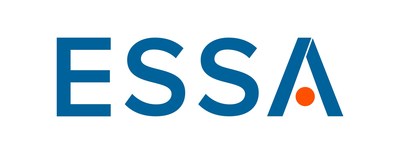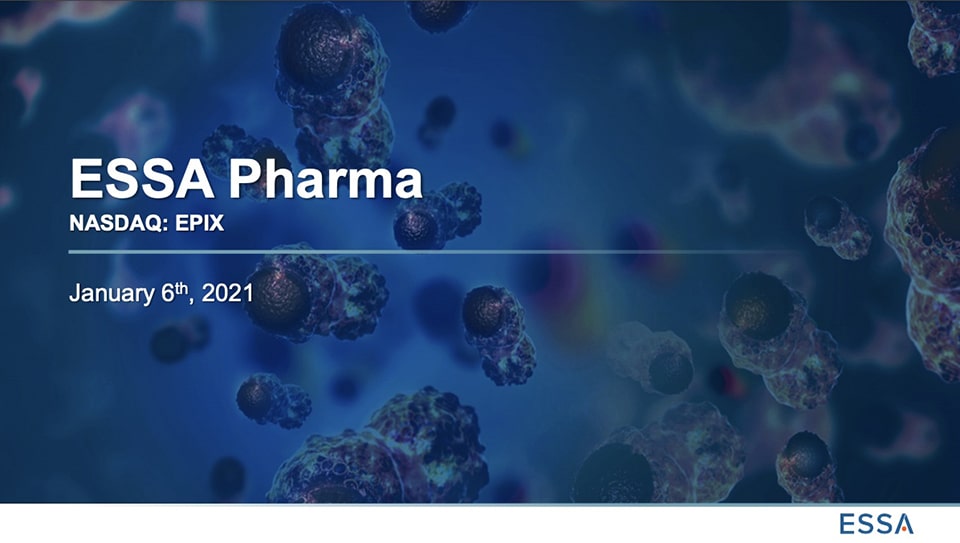

HOUSTON and VANCOUVER, May 17, 2017 /CNW/ - ESSA Pharma Inc. (TSX: EPI; NASDAQ: EPIX) ("ESSA" or the "Company"), a clinical-stage pharmaceutical company focused on the development of novel small molecule drugs for the treatment of prostate cancer, announced that early data from the Phase 1 portion of the ongoing Phase 1/2 clinical trial of its product candidate, EPI-506, will be presented in a poster presentation at the upcoming 2017 American Society for Clinical Oncology ("ASCO") Annual Meeting held June 2-6, 2017 in Chicago, Illinois. Information contained in the abstract (http://iplanner.asco.org/am2017/#/session/11958) was as of the time of submission on January 31, 2017. ESSA intends to announce updated results at the time of the poster presentation at the ASCO Annual Meeting.

Abstract 5032
Efficacy, safety, tolerability and pharmacokinetics of EPI-506 (ralaniten acetate), a novel androgen receptor (AR) N-terminal domain (NTD) inhibitor, in men with metastatic castration-resistant prostate cancer (mCRPC) progressing after enzalutamide and/or abiraterone.
|
Presenter: |
Kim N. Chi, M.D., British Columbia Cancer Agency, Vancouver, BC |
|
Session Title: |
Genitourinary (Prostate Cancer) |
|
Poster Board: |
#106 |
|
Date/Time: |
Monday, June 5, 2017 at 1:15pm – 4:45pm Central Time |
|
Location: |
Hall A |
EPI-506 is currently in an open-label, single-arm Phase 1/2 dose-escalation study of end-stage patients with metastatic castration-resistant prostate cancer (mCRPC) who have failed existing treatments including abiraterone or enzalutamide, or both, and may have also received one prior line of chemotherapy.
At the time of the abstract submission, minor PSA declines in 3/18 patients had been observed at doses from 80 to 1280 mg. The respective human exposure at these dose levels correlate to sub-therapeutic exposure derived from mouse xenograft studies. The data demonstrate that EPI-506 is well-tolerated with a favorable safety profile, with pharmacokinetics indicating dose proportionality at doses up to 1280 mg. Since the submission of the abstract, the company has completed one additional cohort of 2400 mg, and is currently enrolling patients in two additional cohorts dosed at 3600 mg once-daily or 1800mg twice-daily (3600mg total daily dose).
In a clinical study update in April 2017, ESSA reported that pharmacological results confirmed that a dose of 2400 mg achieves drug exposures within the targeted therapeutic range. ESSA plans to obtain additional data from a broader group of patients at higher dose levels to aid in the determination of an optimal Phase 2 dose.
About ESSA Pharma Inc.
ESSA is a clinical-stage pharmaceutical company focused on developing novel and proprietary therapies for the treatment of castration resistant prostate cancer ("CRPC") in patients whose disease is progressing despite treatment with current therapies. ESSA believes that its product candidate, EPI-506, can significantly expand the interval of time in which patients suffering from CRPC can benefit from hormone-based therapies. Specifically, EPI-506 acts by disrupting the androgen receptor ("AR") signaling pathway, which is the primary pathway that drives prostate cancer growth. EPI-002, the primary metabolite of EPI-506, prevents AR activation by binding selectively to the N-terminal domain ("NTD") of the AR. A functional NTD is essential for activation of the AR. Blocking the NTD prevents activation of the AR by all three known mechanisms of activation. In preclinical studies, blocking the NTD has demonstrated the capability to overcome the known AR-dependent mechanisms of CRPC. ESSA was founded in 2009.
About Prostate Cancer
Prostate cancer is the second-most commonly diagnosed cancer among men and the fifth most common cause of male cancer death worldwide (Globocan, 2012). Adenocarcinoma of the prostate is dependent on androgen for tumor progression and depleting or blocking androgen action has been a mainstay of hormonal treatment for over six decades. Although tumors are often initially sensitive to medical or surgical therapies that decrease levels of testosterone, disease progression despite castrate levels of testosterone generally represents a transition to the lethal variant of the disease, mCRPC, and most patients ultimately succumb to the illness. The treatment of mCRPC patients has evolved rapidly over the past five years. Despite these advances, additional treatment options are needed to improve clinical outcomes in patients, particularly those who fail existing treatments including abiraterone or enzalutamide, or those who have contraindications to receive those drugs. Over time, patients with mCRPC generally experience continued disease progression, worsening pain, leading to substantial morbidity and limited survival rates. In both in vitro and in vivo animal studies, ESSA's novel approach to blocking the androgen pathway has been shown to be effective in blocking tumor growth when current therapies are no longer effective.
Forward-Looking Statement Disclaimer
This release contains certain information which, as presented, constitutes "forward-looking information" within the meaning of the Private Securities Litigation Reform Act of 1995 and/or applicable Canadian securities laws. Forward-looking information involves statements that relate to future events and often addresses expected future business and financial performance, containing words such as "anticipate", "believe", "plan", "estimate", "expect", and "intend", statements that an action or event "may", "might", "could", "should", or "will" be taken or occur, or other similar expressions and includes, but is not limited to, statements about the Company's Phase 1 clinical trial, including data and results thereof, and the Company's planned announcement of such data and results; expectations regarding the initiation of the Phase 2 dose expansion study, including statements about the dose levels and expected timing thereof; and the implementation of the Company's business model and strategic plans.
Forward-looking statements and information are subject to various known and unknown risks and uncertainties, many of which are beyond the ability of ESSA to control or predict, and which may cause ESSA's actual results, performance or achievements to be materially different from those expressed or implied thereby. Such statements reflect ESSA's current views with respect to future events, are subject to risks and uncertainties and are necessarily based upon a number of estimates and assumptions that, while considered reasonable by ESSA as of the date of such statements, are inherently subject to significant medical, scientific, business, economic, competitive, political and social uncertainties and contingencies. In making forward looking statements, ESSA may make various material assumptions, including but not limited to (i) the accuracy of ESSA's financial projections; (ii) the Phase 1 portion of the Phase 1/2 clinical trial proceeding as expected; (iii) obtaining positive results of clinical trials; (iv) obtaining necesarry regulatory approvals; and (v) general business, market and economic conditions.
Forward-looking information is developed based on assumptions about such risks, uncertainties and other factors set out herein and in ESSA's Annual Report on Form 20-F dated December 14, 2016 under the heading "Risk Factors", a copy of which is available on ESSA's profile at the SEDAR website at www.sedar.com, ESSA's profile on EDGAR at www.sec.gov, and as otherwise disclosed from time to time on ESSA's SEDAR profile. Forward-looking statements are made based on management's beliefs, estimates and opinions on the date that statements are made and ESSA undertakes no obligation to update forward-looking statements if these beliefs, estimates and opinions or other circumstances should change, except as may be required by applicable Canadian and United States securities laws. Readers are cautioned against attributing undue certainty to forward-looking statements.
SOURCE ESSA Pharma Inc

